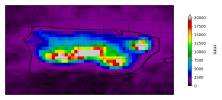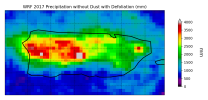So this here's a strange one.
A while back my advisor and I ran a 3-domain simulation centered on Puerto Rico where we used wrfchem to add dust for the SAL. We've only now gotten around to analyzing the results and it's given some odd precipitation quantities. The no-dust (no wrfchem) run looks perfectly fine. The dust run features these massive blocks of heavy precipitation in the 2nd domain and upwards of 25 meters of rain in the 3rd domain.
 This is a comparison of the dust run (red) and the non-dust run (blue).
This is a comparison of the dust run (red) and the non-dust run (blue).
 This d03 centered on PR depicting over 20 meters of rainfall. This is across the entire year of 2017, but even over a year it seems bizarre.
This d03 centered on PR depicting over 20 meters of rainfall. This is across the entire year of 2017, but even over a year it seems bizarre.
 Comparatively, this is what the non-dust run looks like.
Comparatively, this is what the non-dust run looks like.
So there are two problems. The 1st: Why are there blocks of precipitation occurring in d02?
The 2nd: Why does D03 have staggering rainfall?
I'm currently thinking that WRFchem doesn't play very nice with ndown. I ran ndown as it proved to be faster than letting all three domains run at once, but we found out that the dust wasn't carrying over between domains. So I ran the first two domains as normal then used ndown for the third domain. The thinking here being that while the dust might not carry over through ndown, the weather impacts would.
Has anyone used WRFchem dust with ndown who can set me straight on this?
Unfortunately because these runs were made a while back, I only have the namelist.input file left and no logs so I understand there could be any number of things going wrong here that are quite difficult to diagnose. Thanks for any help that can be offered!
A while back my advisor and I ran a 3-domain simulation centered on Puerto Rico where we used wrfchem to add dust for the SAL. We've only now gotten around to analyzing the results and it's given some odd precipitation quantities. The no-dust (no wrfchem) run looks perfectly fine. The dust run features these massive blocks of heavy precipitation in the 2nd domain and upwards of 25 meters of rain in the 3rd domain.
 This is a comparison of the dust run (red) and the non-dust run (blue).
This is a comparison of the dust run (red) and the non-dust run (blue). This d03 centered on PR depicting over 20 meters of rainfall. This is across the entire year of 2017, but even over a year it seems bizarre.
This d03 centered on PR depicting over 20 meters of rainfall. This is across the entire year of 2017, but even over a year it seems bizarre. Comparatively, this is what the non-dust run looks like.
Comparatively, this is what the non-dust run looks like. So there are two problems. The 1st: Why are there blocks of precipitation occurring in d02?
The 2nd: Why does D03 have staggering rainfall?
I'm currently thinking that WRFchem doesn't play very nice with ndown. I ran ndown as it proved to be faster than letting all three domains run at once, but we found out that the dust wasn't carrying over between domains. So I ran the first two domains as normal then used ndown for the third domain. The thinking here being that while the dust might not carry over through ndown, the weather impacts would.
Has anyone used WRFchem dust with ndown who can set me straight on this?
Unfortunately because these runs were made a while back, I only have the namelist.input file left and no logs so I understand there could be any number of things going wrong here that are quite difficult to diagnose. Thanks for any help that can be offered!
